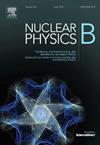基于扩展解耦的无复杂性各向异性星的场论构造
IF 2.8
3区 物理与天体物理
Q2 PHYSICS, PARTICLES & FIELDS
引用次数: 0
摘要
修正的重力理论为解决自重力系统的稳定性和结构特征提供了令人信服的替代方案。在这项工作中,我们利用扩展的引力解耦方法探讨了f(R,T,Q)引力框架内各向异性致密物体的动力学。我们从球对称各向异性种子解出发,加入了一个额外的引力源,并在强物质-几何耦合下建立了相应的场和守恒方程。通过施加匹配和Kuchowicz条件来确定未知度量函数,建立了解析结构。此外,我们引入无复杂性条件和各向同性约束来分析耦合效应对系统物理活力和稳定性的影响。我们的研究结果表明,物质-曲率相互作用显著增强了系统的稳定构型,降低了系统的整体复杂性。还研究了解耦参数的影响,以说明物理参数的敏感性,并通过图形分析加以支持。这些发现提供了对扩展重力和各向异性效应在致密恒星物体的形成和演化中的作用的更深入的了解。本文章由计算机程序翻译,如有差异,请以英文原文为准。
Field-theoretic construction of complexity-free anisotropic stars via extended decoupling
Modified theories of gravity have offered compelling alternatives for addressing the stability and structural features of self-gravitating systems. In this work, we explore the dynamics of anisotropic compact objects within the framework of gravity using an extended gravitational decoupling approach. Starting with a spherically symmetric anisotropic seed solution, we incorporate an additional gravitational source and formulate the corresponding field and conservation equations under strong matter-geometry coupling. The analytical structure is developed by imposing matching and Kuchowicz conditions to determine the unknown metric functions. Furthermore, we introduce a complexity-free condition along with an isotropized constraint to analyze the influence of coupling effects on the physical viability and stability of the system. Our results indicate that the matter-curvature interaction significantly enhances the stable configurations and reduces the overall complexity of the system. The impact of the decoupling parameter is also studied to illustrate the sensitivity of physical parameters, supported through graphical analysis. These findings provide deeper insight into the role of extended gravity and anisotropic effects in the formation and evolution of compact stellar objects.
求助全文
通过发布文献求助,成功后即可免费获取论文全文。
去求助
来源期刊

Nuclear Physics B
物理-物理:粒子与场物理
CiteScore
5.50
自引率
7.10%
发文量
302
审稿时长
1 months
期刊介绍:
Nuclear Physics B focuses on the domain of high energy physics, quantum field theory, statistical systems, and mathematical physics, and includes four main sections: high energy physics - phenomenology, high energy physics - theory, high energy physics - experiment, and quantum field theory, statistical systems, and mathematical physics. The emphasis is on original research papers (Frontiers Articles or Full Length Articles), but Review Articles are also welcome.
 求助内容:
求助内容: 应助结果提醒方式:
应助结果提醒方式:


